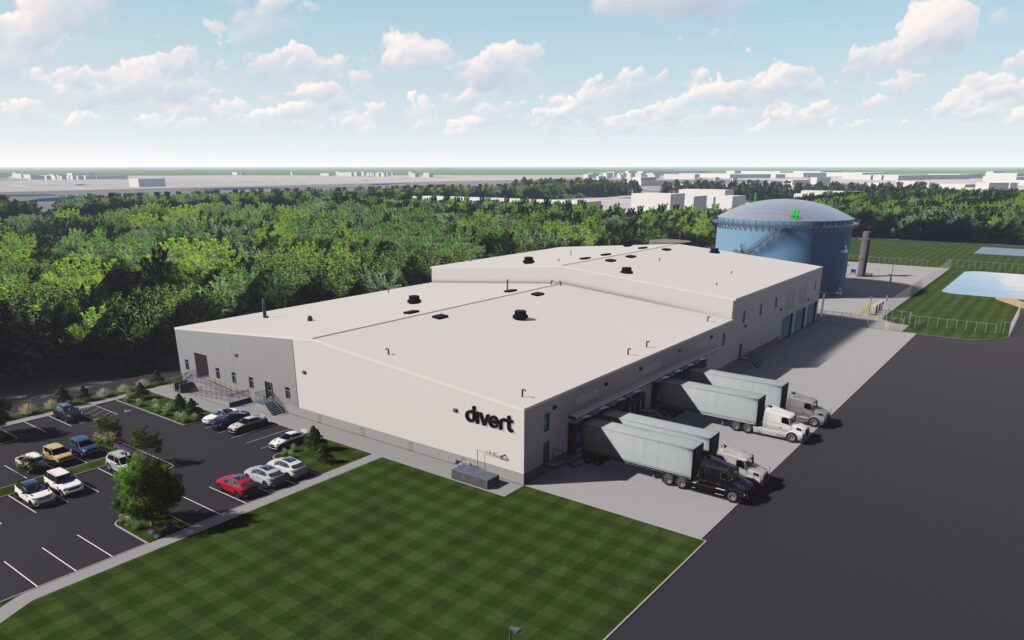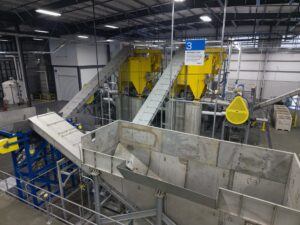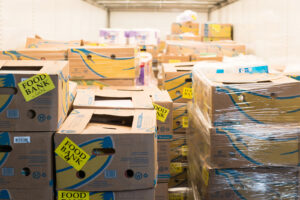September 7, 2023
Divert, Inc., an impact technology company on a mission to Protect the Value of Food™, today announced the groundbreaking on its Integrated Diversion & Energy Facility in Longview, Washington, the first-of-its-kind in the state. The new facility will have the capacity to process 100,000 tons of wasted food a year from Washington and Oregon into carbon negative renewable energy, bringing the region closer to its goals to reduce wasted food and greenhouse gas (GHG) emissions.

“Divert is at the forefront of the fight against wasted food, driving significant progress across the U.S., and now in a first for the state of Washington,” said Ryan Begin, CEO and co-founder, Divert. “Leveraging 16 years of leadership and knowledge in the industry, our company is eager to support businesses across Washington and Oregon in preventing waste and complying with food waste legislation. This is an important moment for Divert and the Pacific Northwest in driving transformative change for the industry and solidifying our commitment to a waste-free world.”
Washington generates more than 2.7 million tons of wasted food annually, of which approximately one million goes to landfill and 47% is still edible food. In Oregon, 1.11 million tons of wasted food were generated in 2021, with nearly 30% going to landfill. The Longview facility will enable Pacific Northwest commercial waste generators and local jurisdictions to address this problem and comply with Washington’s HB 1799 legislation and Organics Management Law, as well as Oregon Metro’s Food Scraps Policy. The facility will be able to accept wasted food from retail food customers, as well as agricultural food producers, industrial food manufacturers, local jurisdictions, restaurants, foodservice, institutional, or commercial waste generators.
The 66,000-square-foot facility will provide companies with actionable data to take preventative steps to waste less and donate more food that is still edible. Leveraging Divert’s proprietary depackaging process and anaerobic digestion, the facility will also transform waste from retailers and other companies into carbon negative renewable energy, thereby preventing it from emitting harmful methane in landfills. Once fully operational in 2024, the facility will be able to offset up to 23,000 metric tons of CO2 a year at full processing capacity, equivalent to removing 5,000 gas-powered cars from the road annually.
This is a very bright spot for the whole State of Washington, to see this kind of economic development that creates jobs by taking a waste product and turning it into affordable energy.
Washington Senator Maria Cantwell
Divert and energy infrastructure company, Enbridge Inc., are together expecting to invest nearly $100 million into the project and the local economy.
“We’re excited to see Longview start construction,” said Caitlin Tessin, Vice President Strategy & Market Innovation, Enbridge. “Since Divert and Enbridge announced our infrastructure agreement for up to $1 billion earlier this year, Divert has continued to lead the industry in solutions to mitigate wasted food and greenhouse gas emissions across the U.S. and is lined up to play an important role in Enbridge’s energy transition strategy.”
Divert operates 10 facilities across the U.S. working with nearly 5,400 retail stores to process more than 2.3 billion pounds of wasted food. In April, the company broke ground on another Integrated Diversion & Energy Facility in Turlock, California. The Longview facility brings Divert closer to delivering on its commitment to expand to 30 facilities across the U.S. to be within 100 miles of 80% of the population by 2031.
“This is a very bright spot for the whole State of Washington, to see this kind of economic development that creates jobs by taking a waste product and turning it into affordable energy,” said Washington Senator Maria Cantwell. “This type of project is exactly what we had in mind when we got the expansion of the clean energy tax credit in the Inflation Reduction Act. I’m happy that the tax credit expedited this project and made this concept viable.”
“Our city is honored to welcome Divert to be a part of the community here in Southwest Washington,” said MaryAlice Wallis, Mayor of Longview. “I believe that Divert fits what Longview’s founder Robert A. Long envisioned 100 years ago by supporting economic growth and adding nearly 40 new jobs, and attracting innovative businesses that accelerate our carbon reduction and renewable energy goals. Our community looks forward to celebrating our alliance with Divert for years to come.”
About Divert, Inc.
Divert, Inc. is an impact technology company on a mission to Protect the Value of Food™. Founded in 2007, the company creates advanced technologies and sustainable infrastructure to eliminate wasted food, driving social and environmental impact. Divert provides an end-to-end solution that prevents waste by maximizing the freshness of food, recovers edible food to serve communities in need, and converts wasted food into renewable energy. The company works with five Fortune 100 companies and nearly 5,400 retail stores across the U.S., helping food retailers to reach their sustainability goals.
Divert Media Contact
Caroline Legg
Director of Public Relations
(203) 313-4228
clegg@divertinc.com



